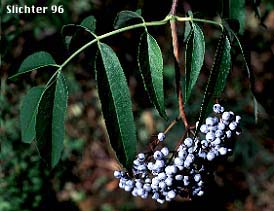Blue elderberry is a tall shrub to small tree with one to many stems arising from the base to 2-10 meters in height with the diameter of the trunk up to 25 cm. The stems are soft, glaucous and hollow, with the interior hollow space often filled with a light pith like stryofoam. The leaves are pinnately compound with 5-9 lanceolate or lance-ovate leaflets which taper to a point. The margins are sharply toothed and the base of each leaflet is often unequally shaped. Individual leaflets range from 5-15 cm long and 2-6 cm wide. The blades are glabrous with the upper surface dark green and the lower a paler green.
The inflorescence is broad, flattened panicle of many tiny white flowers. This flat-topped surface ranges from 4-20 cm in diameter. Individual flowers measure 4-7 mm across and have 5 petals. The fruits are bluish-black and coated with a dense, silvery and waxy bloom of yeast, giving the fruits a pale, powder-blue appearance. The fruits are globose in shape and measure 4-6 mm across.
Elderberry contains hydrocyanic acid which can lead to mild cyanide poisoning if consumed in large quantities. The leaves and bark contain the highest concentration of this chemical and should not be ingested. The berries of blue elderberry may be safely consumed and are used to make jams, jellies, pies and wines. In preparing these foodstuffs, one must be aware that the seeds still contain hydrocyanic acid. To remove this threat, one must thoroughly cook the berries and then strain out the seeds. The various species of elderberry are all suitable as large shrubs for native woodland or riparian plantings. Be aware however, that birds upon eating the fruits, will soon be spreading the seeds to new, hopefully desirable locations!Blue elderberry may be found in open woods and valley bottoms from near sea level to moderate elevations in the mountains.
Blue elderberry may be found from southern British Columbia east to western Montana. It may be found southward to California in the west and through the Rocky Mts. in the east to Arizona and New Mexico.
Close-ups of the inflorescence and pinnately compound leaves as well as a habitat shot of blue elderberry as seen on slopes above the Klickitat River in the Klickitat State Wildlife Area of south-central Washington..........May 31, 2009.
